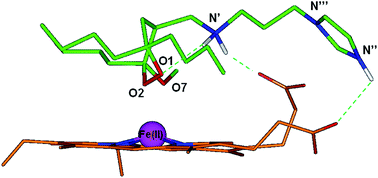New antimalarial 3-methoxy-1,2-dioxanes: optimization of cellular pharmacokinetics and pharmacodynamics properties by incorporation of amino and N-heterocyclic moieties at C4†
Abstract
A new series of nineteen 3-methoxy-1,2-dioxanes containing an amino moiety at C4 was designed, synthesized and tested for in vitro antimalarial activity against chloroquine sensitive (CQ-S) D10 and chloroquine resistant (CQ-R) W2 strains of Plasmodium falciparum (Pf). Cytotoxicity against the human endothelial cell line (HMEC-1) was also evaluated. The introduced modifications resulted in a notable improvement of the antimalarial activity. In particular, compound 9a with an amino-imidazole side-chain at C4 displays antimalarial activity in the high nanomolar range against the CQ-R Pf strain (W2 IC50 = 200 nM), being more active against CQ-R than CQ-S Pf strains and devoid of cytotoxicity against human HMEC-1 cells. On the other hand, some of the hybrids with 4-amino-7-chloroquinoline (9k–p) show an IC50 comparable to that of chloroquine against the CQ-S Pf strain (9k–p, D10 IC50 = 50–90 nM) but without losing potency against the CQ-R Pf strain (9k–p, resistance index = 1.2–2.6), with low cytotoxicity against HMEC-1. Structure–activity relationship studies show that the improved antimalarial activity of the new compounds is the result of a combination of cellular pharmacokinetics and pharmacodynamics effects.


 Please wait while we load your content...
Please wait while we load your content...